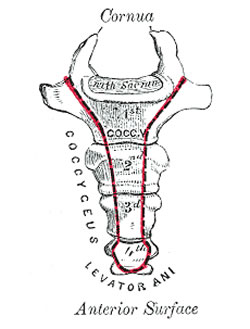The word [coccyx] arises from the Greek term [κούκος] (pronounced koúkos)and means "cuckoo". It is the name of the lower segment of the spinal column, and was named by Herophilus of Alexandria (325-255BC) because of a resemblance of this structure to the bill of the cuckoo bird. Vesalius also used the same analogy. There is another structure of the body named after the beak of a bird, do you know it? If not, click here.
The coccyx (vernacularly known as "tailbone") is usually represented by four rudimentary vertebrae, although the number varies between 3 to 5 vertebrae. There have been reported cases of "human tails" but these do not have a bony structure and are usually related to congenital abnormalities such as spina bifida.
The coccyx has a well-formed superior component, which usually presents with two cornua (horns) which serve as part of a rudimentary zygapophyseal (facet) joint. The lower coccygeal vertebra is usually a small bony node.
The coccyx has an anterior sacrococcygeal ligament, which is continued with the anoccygeal raphe, a ligamentous structure that serves as a posterior attachment for muscular components of the pelvic diaphragm, and helps anchor the anal canal. The coccygeus muscle, the posterior component of the pelvic diaphragm and part of the sacrospinous ligament also attach to the anterolateral aspect of the coccyx.
Coccygeal pain is referred to as coccydynia.
Sources:
1. "The Origin of Medical Terms" Skinner, HA 1970 Hafner Publishing Co.
2. "Medical Meanings - A Glossary of Word Origins" Haubrich, WD. ACP Philadelphia
3. "Dorlands's Illustrated Medical Dictionary" 26th Ed. W.B. Saunders 1994
5 "Tratado de Anatomia Humana" Testut et Latarjet 8 Ed. 1931 Salvat Editores, Spain
6. "Anatomy of the Human Body" Henry Gray 1918. Philadelphia: Lea & Febiger
Image modified by CAA, Inc. Original image courtesy of bartleby.com
Note: Google Translate includes the symbol (?). Clicking on it will allow you to hear the pronunciation of the word.




